Equipment
Vokey opens its Tour Department to the public
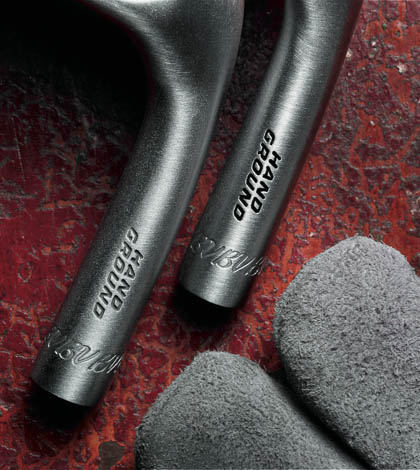
Call it WedgeWorks on steroids.
Titleist has announced that the custom wedge grinding services it offers to its tour players will be available to the public starting June 19.
Titleist calls the program “WedgeWorks Hand Ground,” and it will allow consumers to order 58- or 60-degree wedges in custom grinds that have previously only been available to tour players.
The wedges will retail for $350, and will be hand ground by the same master craftsman on the same grinding wheels as those made for Steve Stricker, Zach Johnson, Adam Scott, Jason Dufner and many other PGA Tour winners.
The Hand Ground wedges will be available in the following tour-only grinds:
- V Grind (left): Its crescent-shaped sole has plenty of bounce in the front to prevent digging. But it has a narrow sole and minimal camber that allows versatility around the greens. According to Vokey.com, the V Grind is great for players with steep angles of attack, or those who play in soft conditions.
- E Grind (middle): Its medium-width sole has a straight relieved trailing edge. It also has a slight heel camber that allows it to be played in the opened position, and additional heel relief can be added by request. Its forgiving sole is great for medium-to-steep angles of attack, and is most effective in soft conditions.
- T Grind (right): The T Grind was inspired by Champions Tour player Tom Pernice. Its crescent-shaped, thin flat sole has ample relief in the heel, toe and trailing edge sections. It also has a narrow forward bounce section and a medium amount of camber that plays well in tight, firm conditions, and is great for players with shallower angles of attack.
Vokey’s M Grind, which is available on Vokey retail models 54-11, 56-11, 58-12 and 60-10, is another option through the Hand Ground program. It’s one of Vokey’s most versatile soles, with a medium amount of camber and bounce and ample relief in the heel, toe and trailing edge areas.
More exclusives
Each hand ground wedge will come in a tour-only raw finish, which allows wedges to be shaped in nearly any way. Golfers can choose to have their wedges made with a square toe, straighter leading edge, beveled top line, pre-worn leading edge, or a pro-groove — a subtle channel in the center of the sole that is used by Webb Simpson on his 58-degree Vokey TVD-M wedge.
According to Vokey, the pro-groove moves the contact point of the wedge slightly forward, which allows golfers to more easily use the bounce on short pitches to prevent digging.
Like Vokey’s WedgeWorks program, golfers can choose to have their wedges customized with different stampings — eight different letter/number combinations in “straight,” “freestyle,” “staircase” or “snow” — and 12 different paintfill colors. All the shafts, grips, ferrules, weight porting and shaft bands offered through Vokey’s WedgeWorks program will also be available.
Golfers will also have the choice of the following WedgeWorks Hand Ground exclusive stamps: “Prototype 2013,” “Hand Ground, “Special Grind” and “BVHG” (Bob Vokey Hand Ground). They can also choose “Spin Milled,” the name for the high-friction grooves that are milled into each Vokey wedge.
Wedges that are ordered through the Hand Ground program will have a hand-stamped hosel code, and the grinder’s initials will be stamped on the wedges as well. For example, wedges ground by Vokey Tour Rep Aaron Dill will be stamped “AD,” while wedges ground by Vokey himself will be stamped “BV.”
According to David Neville, Vokey marketing manager, the company will call every customer who makes an order through WedgeWorks Hand Ground to make sure they know exactly what wedge grinds they’ve ordered and confirm that it will work for them.
Titleist expects that turnaround time on orders to be between two and three weeks.
- LIKE0
- LEGIT0
- WOW0
- LOL0
- IDHT0
- FLOP0
- OB0
- SHANK0
Whats in the Bag
WITB Time Machine: Danny Willett’s winning WITB, 2016 Masters
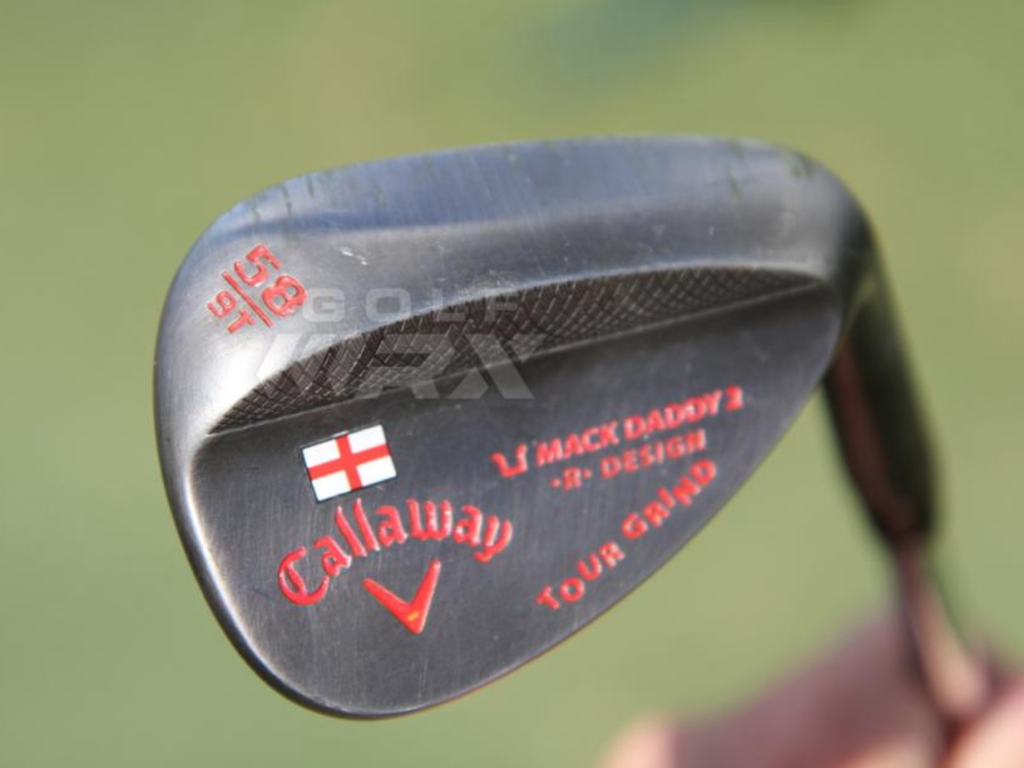
Driver: Callaway XR 16 (9 degrees)
Shaft: Mitsubishi Rayon Diamana W-Series 60 X
Length: 45.5 inches
3-wood: Callaway XR 16 (15 degrees)
Shaft: Mitsubishi Rayon Diamana W-Series 70X
5-wood: Callaway XR 16 (19 degrees)
Shaft: Mitsubishi Rayon Diamana W-Series 80X
Irons: Callaway Apex UT (2, 4), Callaway Apex Pro (5-9)
Shaft: True Temper Dynamic Gold X100 Superlite
Wedges: Callaway Mack Daddy 2 (47-11 S-Grind) Callaway Mack Daddy 2 Tour Grind (54-11, 58-9)
Shaft: True Temper Dynamic Gold X100 Superlite
Putter: Odyssey Versa #1 Wide (WBW)
Lie angle: 71 degrees
Ball: Callaway Speed Regime SR-3
Check out more photos of Willett’s equipment from 2016 here.
- LIKE7
- LEGIT0
- WOW1
- LOL0
- IDHT0
- FLOP0
- OB0
- SHANK0
Equipment
Project X Denali Blue, Black shaft Review – Club Junkie Review
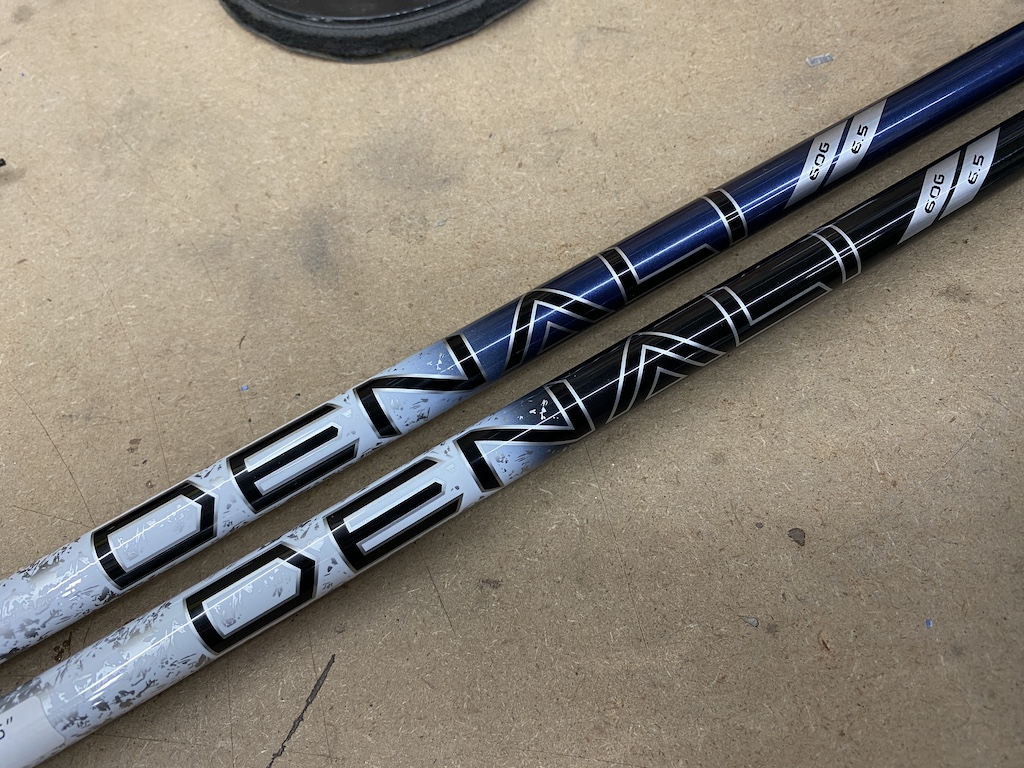
Originally, Project X was known for low-spin steel iron shafts. However, the company might now be known for wood shafts. Denali is the newest line of graphite shafts from Project X. With the Denali line, the company focuses on feel as well as performance.
There are two profiles in the Denali line, Blue and Black, to fit different launch windows. Denali Blue is the mid-launch and mid-spin profile for players who are looking for a little added launch and Denali Black is designed for low-launch and low-spin. Both models are going to offer you a smooth feel and accuracy.
For a full in-depth review check out the Club Junkie podcast on all podcast streaming platforms and on YouTube.
Project X Denali Blue
I typically fit better into mid-launch shafts, as I don’t hit a very high ball so the Denali Blue was the model I was more excited to try. Out of the box, the shaft looks great and from a distance, it is almost hard to tell the dark blue from the Denali Black. With a logo down install of the shaft, you don’t have anything to distract your eyes, just a clean look with the transition from the white and silver handle section to the dark navy mid and tip.
Out on the course, the Blue offers a very smooth feel that gives you a good kick at impact. The shaft loads easily and you can feel the slightly softer handle section compared to the HZRDUS lineup. This gives the shaft a really good feel of it loading on the transition to the downswing, and as your hands get to impact, the Denali Blue keeps going for a nice, strong kick.
Denali Blue is easy to square up at impact and even turn over to hit it straight or just little draws and most of the flex of the shaft feels like it happens right around where the paint changes from silver to blue. The Blue launches easily and produces what I consider a true mid-flight with the driver. While it is listed as mid-spin, I never noticed any type of rise in my drives. Drives that I didn’t hit perfectly were met with good stability and a ball that stayed online well.
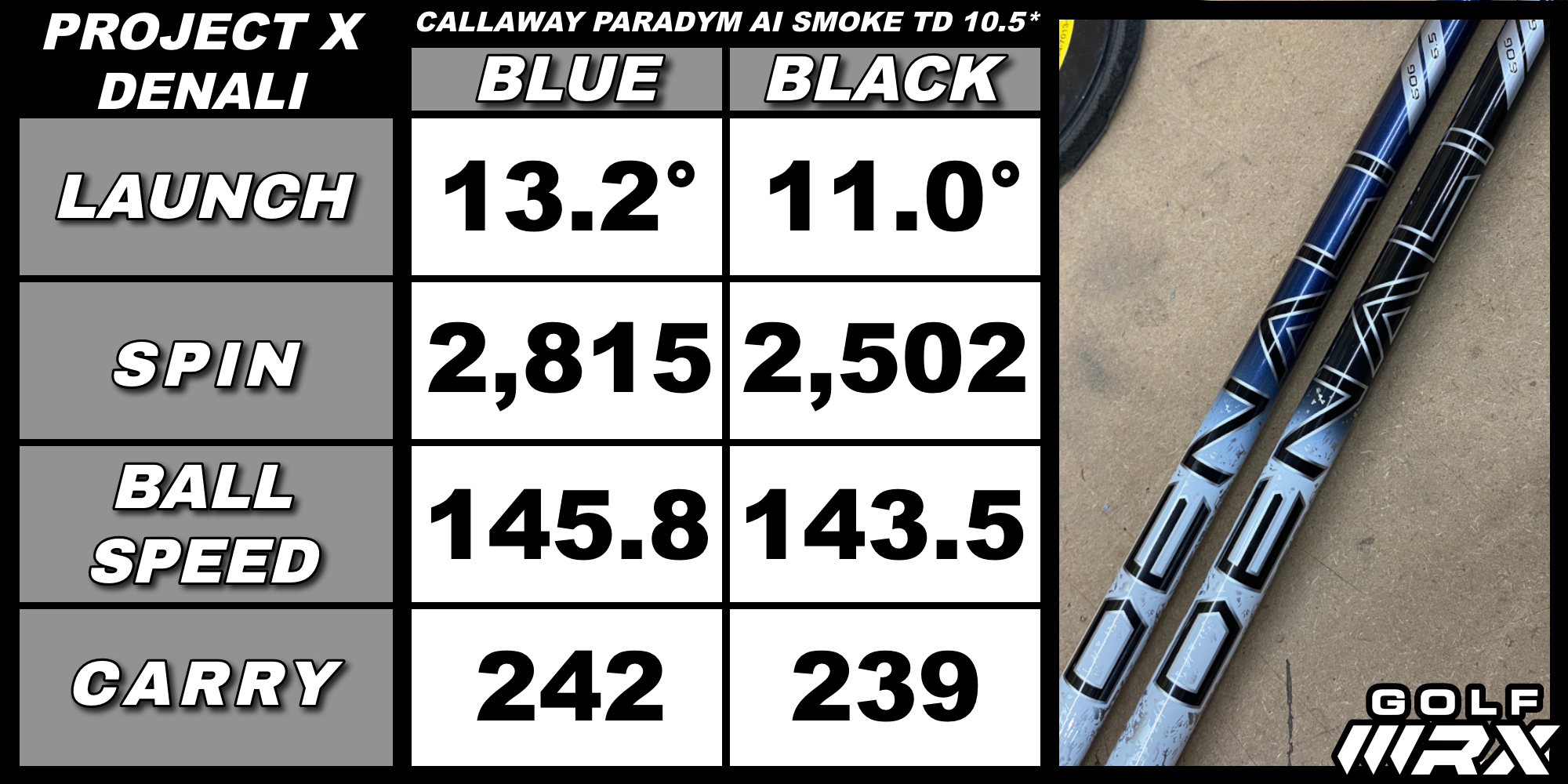
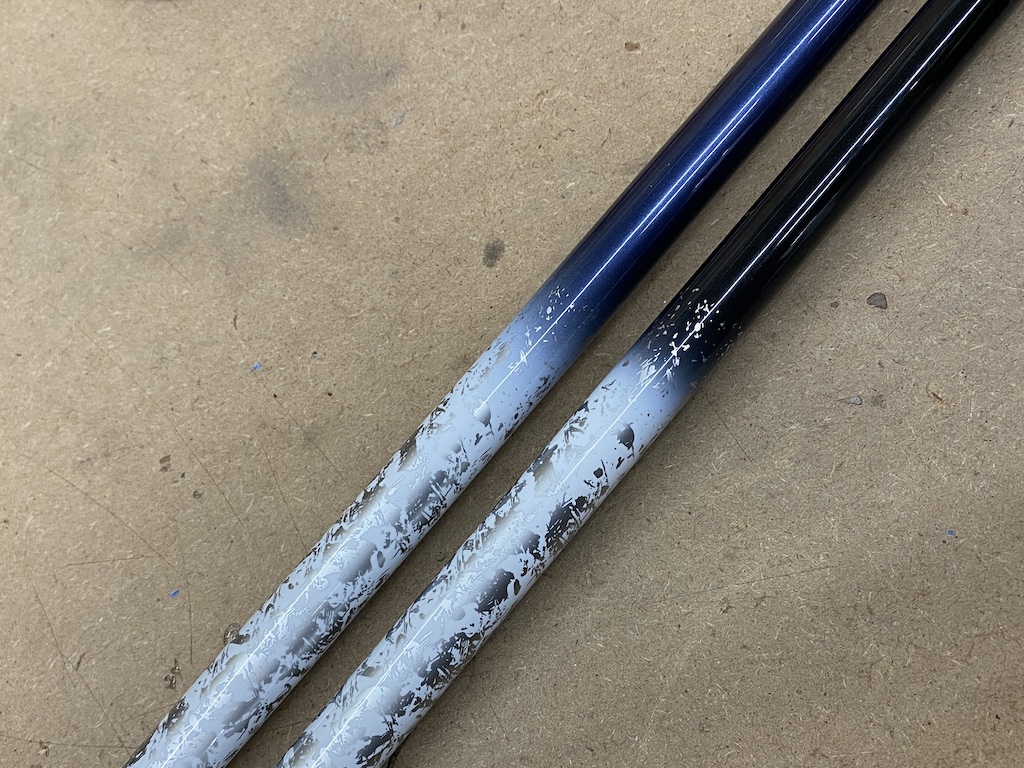
Project X Denali Black
When you hold the Denali Black in your hands you can tell it is a more stout shaft compared to its Blue sibling by just trying to bend it. While the handle feels close to the Blue in terms of stiffness, you can tell the tip is much stiffer when you swing it.
Denali Black definitely takes a little more power to load it but the shaft is still smooth and doesn’t give you any harsh vibrations. Where the Blue kicks hard at impact, the Black holds on a little and feels like keeps you in control even on swings that you try and put a little extra effort into. The stiff tip section also makes it a little harder to square up at impact and for some players could take away a little of the draw from their shot.
Launch is lower and more penetrating compared to the Blue and produces a boring, flat trajectory. Shots into the wind don’t rise or spin up, proving that the spin stays down. Like its mid-launch sibling, the Black is very stable and mishits and keeps the ball on a straighter line. Shots low off the face don’t get very high up in the air, but the low spin properties get the ball out there farther than you would expect. For being such a stout shaft, the feel is very good, and the Denali Black does keep harsh vibrations from your hands.
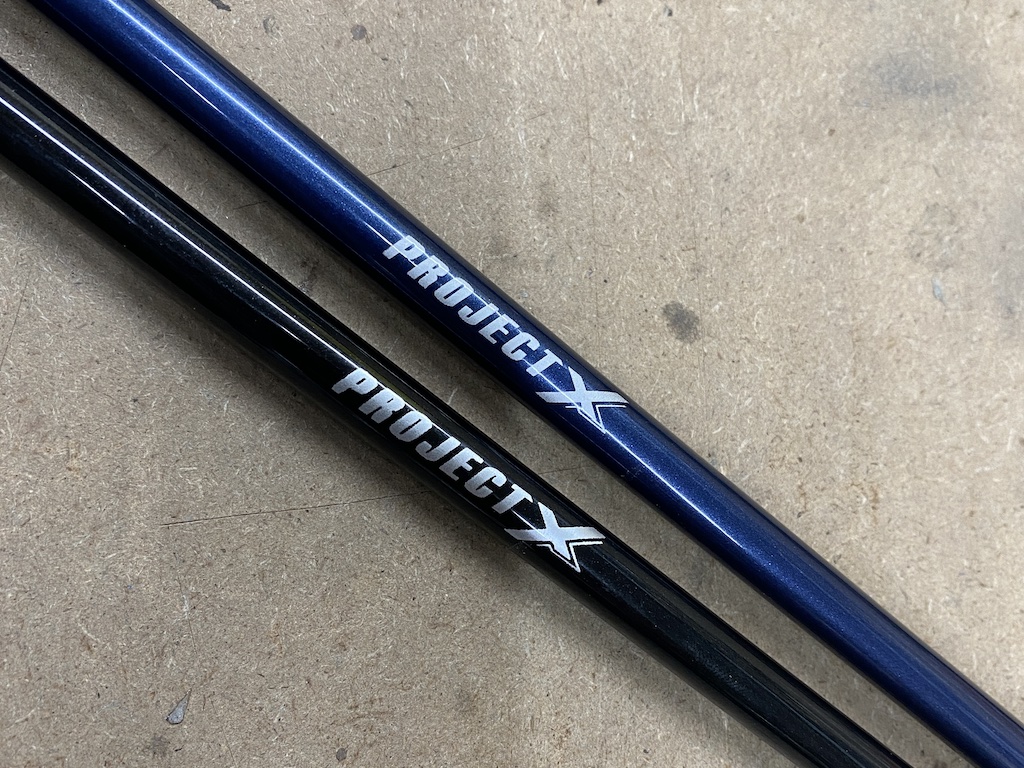
Overall the Project X Denali Blue and Black are great additions to the line of popular wood shafts. If you are looking for good feel and solid performance the Denali line is worth trying out with your swing. Choose Blue for mid-launch and mid-spin or Black for lower launch and low spin.
- LIKE4
- LEGIT4
- WOW2
- LOL0
- IDHT0
- FLOP0
- OB0
- SHANK0
Equipment
What we know about Bryson DeChambeau’s 3D-printed Avoda irons
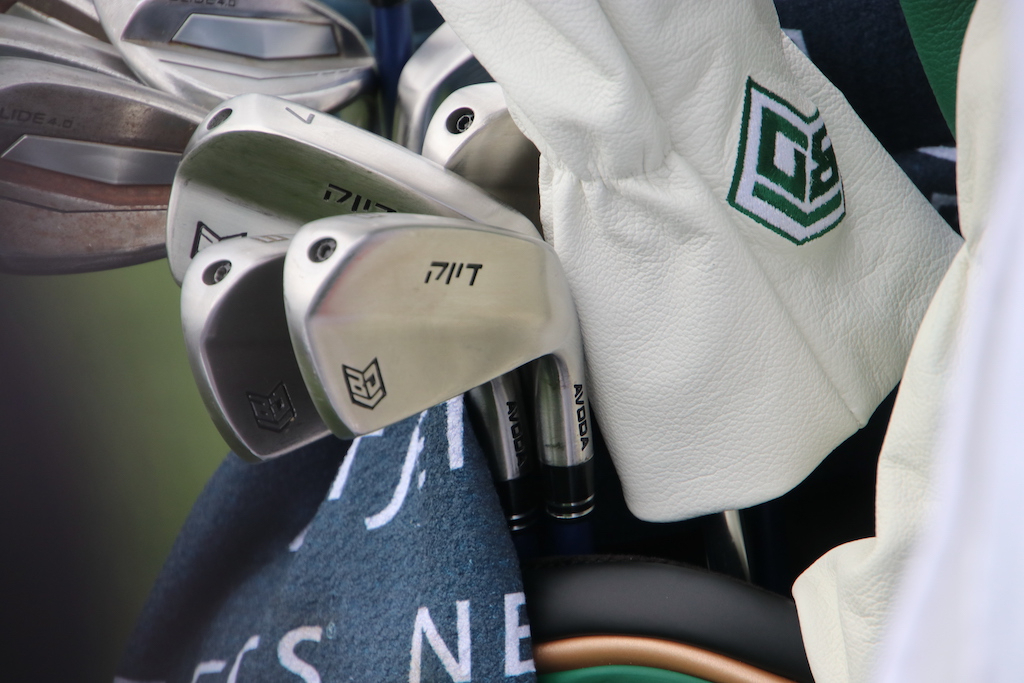
Bryson DeChambeau fired an opening-round 7-under 65 at Augusta National, hitting an impressive 15 of 18 greens in regulation in the process. Golf’s mad scientist’s play grabbed headlines and so too did his equipment. In place of the Ping i230 irons he had in the bag last week for LIV Golf’s Miami event, DeChambeau is gaming a prototype 5-PW set of irons from little-known direct-to-consumer manufacturer Avoda.
What is Avoda Golf?
Founded by Tom Bailey, also a Mike Schy student like Bryson DeChambeau, Avoda Golf is a direct-to-consumer golf equipment company that currently manufactures both single and variable-length irons in one model that are available for pre-order.
What irons is Bryson DeChambeau playing?
Per multiple reports, DeChambeau is playing a custom-designed set of single-length irons that incorporate bulge and roll into the face design. The two-piece 3D-printed irons were reportedly only approved for play by the USGA this week, according to Golfweek’s Adam Schupak.
Regarding the irons, DeChambeau told Golf Channel the irons’ performance on mishits was the determining factor in putting them in play this week. “When I mishit on the toe or the heel,” DeChambeau said. “It seems to fly a lot straighter for me and that’s what has allowed me to be more comfortable over the ball.”
What can we tell about the design of the clubs?
These days, it is a little hard to speculate on what is under the hood with so many hollow body irons. DeChambeau’s irons look to be hollow on the lower section as they do flare back a decent amount. That “muscle” on the back also looks to be fairly low on the iron head, but we can assume that is progressive through the set, moving up higher in the short irons.
A screw out on the toe is probably used to seal up the hollow cavity and used as a weight to dial in the swing weight of the club. From pictures, it is hard to tell but the sole looks to have a little curve from heel to toe while also having some sharper angles on them. A more boxy and sharper toe section looks to be the design that suits Bryson’s eye based on the irons he has gravitated toward recently.
What are bulge and roll, again?
Two types of curvature in a club face, traditionally incorporated only in wood design. Bulge is heel-toe curvature. Roll is crown-sole curvature. Both design elements are designed to mitigate gear effect on off-center strikes and produce shots that finish closer to the intended target line. (GolfTec has an excellent overview of bulge and roll with some handy GIFs for the visual learner)
What else is in DeChambeau’s bag?
Accompanying his traditional Sik putter, Bryson builds his set with a Ping Glide 4.0 wedges, a Krank Formula Fire driver and 5-wood, and a TaylorMade BRNR Mini Driver, all with LA Golf graphite shafts.
- LIKE119
- LEGIT39
- WOW31
- LOL17
- IDHT9
- FLOP9
- OB10
- SHANK25
-

 19th Hole4 days ago
19th Hole4 days agoDave Portnoy places monstrous outright bet for the 2024 Masters
-

 19th Hole3 weeks ago
19th Hole3 weeks agoJohn Daly stuns fans into silence with brutal opening tee shot on PGA Tour Champions
-

 19th Hole2 weeks ago
19th Hole2 weeks agoThings got heated at the Houston Open between Tony Finau and Alejandro Tosti. Here’s why
-

 19th Hole5 days ago
19th Hole5 days agoTiger Woods arrives at 2024 Masters equipped with a putter that may surprise you
-

 19th Hole1 week ago
19th Hole1 week agoReport: Tiger Woods has ‘eliminated sex’ in preparation for the 2024 Masters
-

 19th Hole3 weeks ago
19th Hole3 weeks agoCharlie Woods finds it tough going on American Junior Golf Association debut
-

 19th Hole2 weeks ago
19th Hole2 weeks agoAddiction, spinal fusion, and scam artists – Everything Anthony Kim revealed in candid interview with David Feherty
-

 19th Hole1 week ago
19th Hole1 week agoAnthony Kim says doctors told him that he ‘may not have much time left’ ahead of LIV return



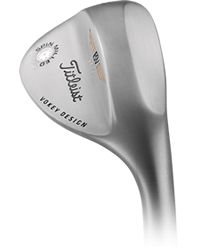
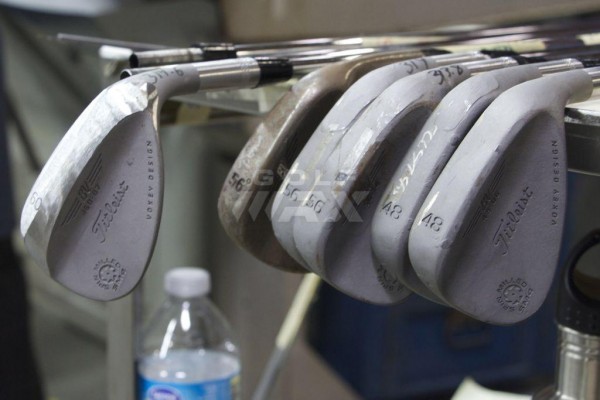


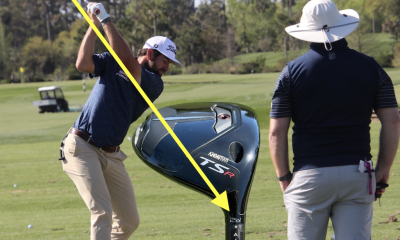



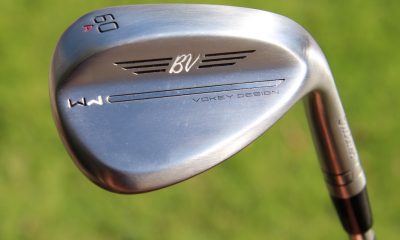

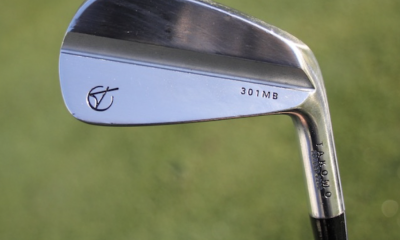



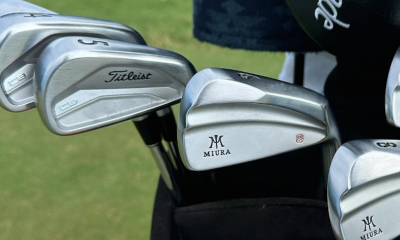

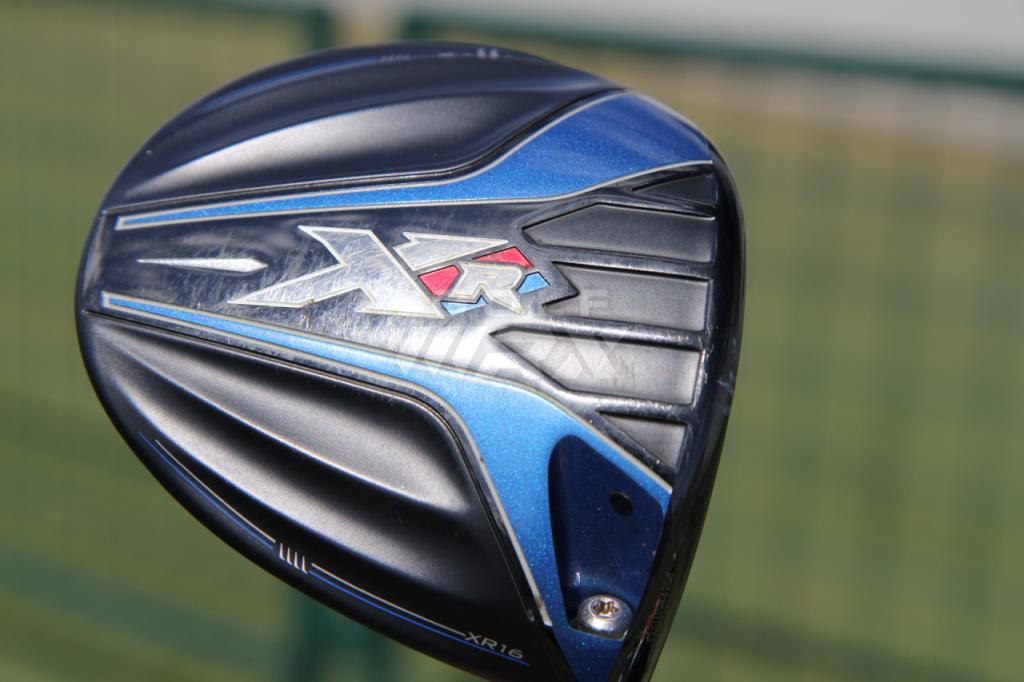
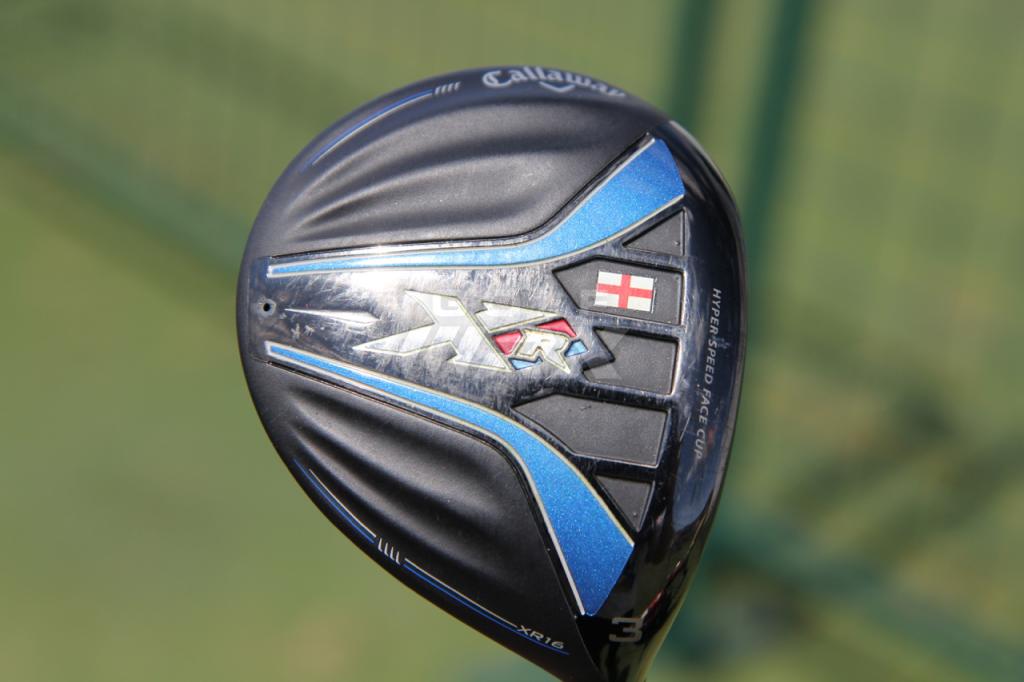

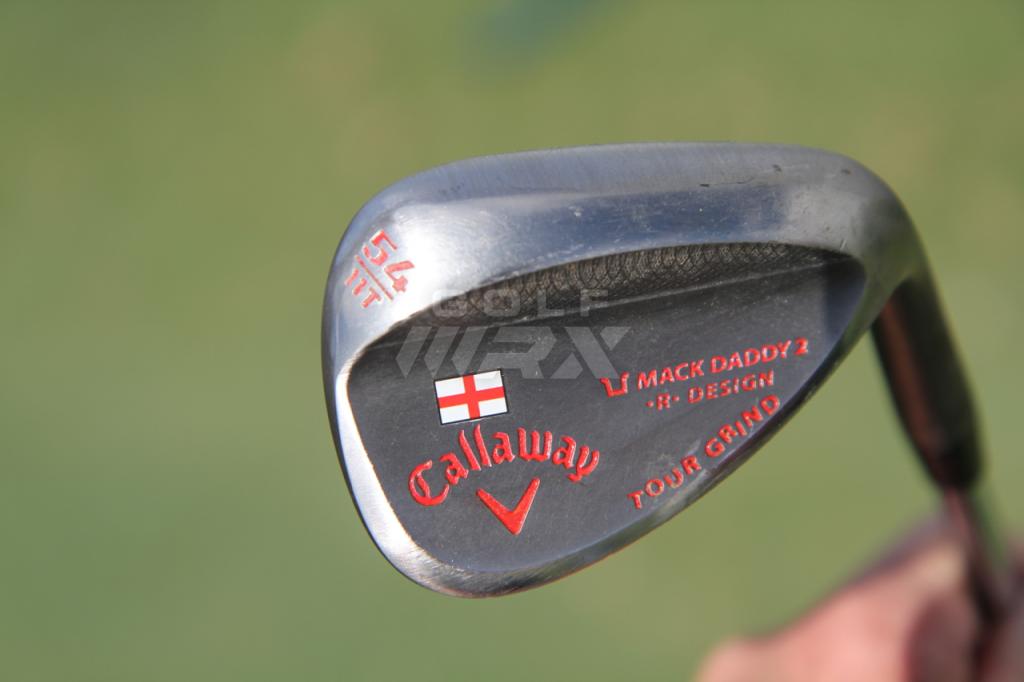
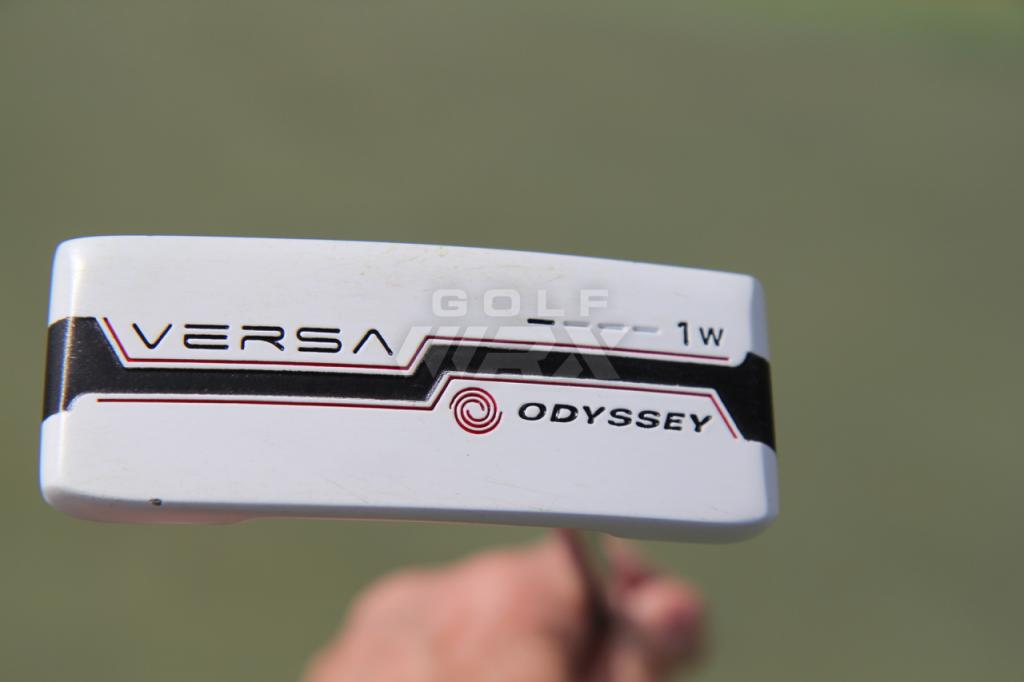














Dino
May 30, 2013 at 2:22 pm
They’ll just be grinding up tour reject heads…Titleist left out the most important factor. Quality of metal tour players get versus what these heads will be made of. I have a couple tour wedges that have amazing feel and the outside looks like everyday chrome…well the chrome flaked away and underneath is pure copper. Hmmm
Ben
May 31, 2013 at 11:15 am
pics?
jb
May 29, 2013 at 8:15 pm
Well what is so different about these wedges then the Scotty Camreon putters? Aren’t those the same people Titleist is targeting now? I think they’ll sell more than enough!
Curt
May 29, 2013 at 9:03 pm
Putters can last a lifetime, wedges last one or two seasons depending on play, so not a good comparison.
J
May 29, 2013 at 5:07 pm
JP Wedges cost that much and you definately get a unique wedge for that much
Todd
May 29, 2013 at 3:57 pm
The best part is that for $350 Vokey may or may not grind it himself. Hell, for this price you may as well just charge $800 for him to do it and $350 for the other guy nobody knows. Anyone crazy enough to pay $350 is willing to pay $800.
Ben
May 29, 2013 at 11:29 am
Miura Golf is holding on line 1…
Bob
May 29, 2013 at 11:26 am
I bought 3 Vokey’s custom 1 inch longer and 3 up. Swing weight as received, E-5. They would not adjust swing weight. I sent them to Hot Stix to be adjusted. For what these cost, custom work should be better, easier and less expensive.
danny
May 29, 2013 at 3:55 pm
But Bob Vokey might walk by while your club is getting worked on here, that’s a great experience that your club will have for a lifetime. He might event touch it which will give you 3 extra hole outs over an off the rack Vokey.
Mick J
May 29, 2013 at 4:36 pm
You must be 8′ tall
danny
May 29, 2013 at 10:54 am
For the record, I have 3 Vokey wedges in my bag, but I see no value in having to pay $350 for Bob Vokey (or maybe his dude) to possibly grind my wedge.
Mike D.
May 29, 2013 at 9:56 am
Or serving a niche market segment, who feel the $350 is justified….
Kevin
May 29, 2013 at 10:48 am
Great move. There is definitely a market for this.
Danny
May 29, 2013 at 12:14 am
Lol $350. They have to be joking or arrogant
Curt
May 29, 2013 at 9:15 am
+1 – that is rediculous, unless they give an “up and down” guarantee along with it! Sorry, no need to overpay, just to over feed my ego!!
Dave
May 29, 2013 at 1:40 pm
Definitely just paying for the experience so you can say “these were hand ground”. I’m sure people will jump all over it though. I’d rather have them done at a custom shop though.